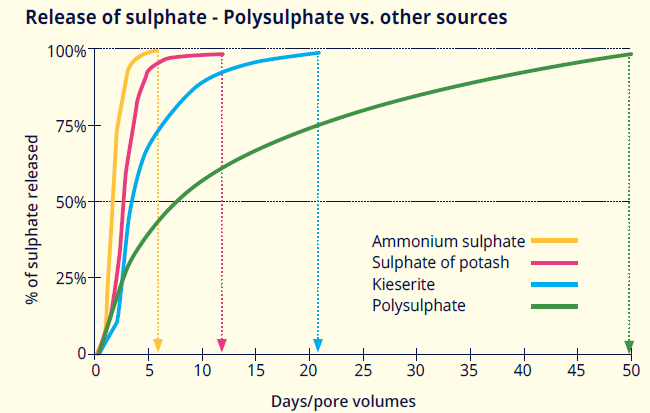Go Slow on Sulphur with Polysulphate
 Polysulphate, a new fertilizer with secondary nutrients
Polysulphate, a new fertilizer with secondary nutrients
All natural Polysulphate has a unique dissolution pattern, releasing its nutrients gradually after application. This provides prolonged availability of sulfate to plants and reduces the risk of S leaching in sandy soils or under high precipitation.
Polysulphate is a new, organic multi-nutrient fertilizer, available in its natural state, and mined in the UK. It has four nutrients, which makes it a unique product: sulphur, magnesium, potassium and calcium. All its nutrients are readily available for plant uptake.
Polysulphate comes from the polyhalite layer of rock, over 3,300 feet below the North Sea off the North Yorkshire coast in the UK. Deposited 260 million years ago, it lies 490-560 feet below the potash seam at the Cleveland Potash Boulby Mine.
Polysulphate is natural and has a low carbon footprint. It delivers dependable high value for low environmental impact and is certified for organic use.
Polysulphate contains: 19.2% S as sulphate, 14% K2O as sulphate of potassium, 3.6% Mg as magnesium sulphate and 12% Ca as calcium sulphate. Its chloride content is very low, thus it can be applied to sensitive crops.
Being a natural crystal, it has a very unique dissolution pattern, releasing its nutrients gradually after being applied to the soil. The extended release period of the nutrients in Polysulphate, particularly the sulphate, offers considerable advantages in practical farm conditions.
Seeing sulphur as a key to unlock performance
Sulphur (S) is a secondary essential nutrient; plants take up S as sulphate anion (SO42-). Sulphur is part of every living cell and required for synthesis of certain amino acids (cysteine and methionine), and proteins. Sulphur is also important in photosynthesis and crop winter hardiness. Leguminous plants need S for efficient nitrogen (N) fixation. Sulphur is prone to leaching and can easily get beyond the reach of crop roots. The result is that crop growth is hindered.
Nitrogen and S work very closely together and demand for N and S is very closely correlated; one major function of N and S is amino acid production and both elements are required together to ensure they are both utilized efficiently in this process. For example, during stem elongation in wheat the N uptake averages 2.2 lbs./acre per day. At the same time the S uptake is on average 0.4 lbs./acre per day, meaning a ratio of the requirement of N to S of 5:1.
Separating S from N application
A common current practice is to apply S with N as ammonium sulphate, but this poses a risk of significant N and S losses. Nitrogen can be lost via volatilization, especially on high pH soils, while sulphate is immediately released from ammonium sulphate and thus is prone to leaching below the rooting zone before it is taken up by the crops.
By using Polysulphate, N can be applied independently, separating S from N application. Nitrogen can be applied after germination at the right time for the crop, in the right form, and in right weather conditions avoiding N overdosing or leaching. With Polysulphate, higher N use efficiency can be achieved without waste and unnecessary cost to the farmer or the environment.
Delivering prolonged release sulphur and more
Farmer awareness of the benefits to crops of prolonged release of S in the soil is growing. The S in Polysulphate comes from 3 sources – calcium, magnesium and potassium sulphate. The unique dissolution pattern of this natural complex crystal, releases its nutrients gradually over time (prolonged availability). Polysulphate has been shown to release S over a long enough period to meet the crop’s requirements for S over the major growth period and is also unaffected by pH. This special solubility characteristic of Polysulphate provides prolonged availability of S to plants, whilst reducing the risk of S leaching in sandy soils and under high precipitation.
The steady, prolonged release of S over a longer period than other fertilizers is a key advantage of Polysulphate. Along with S, Polysulphate provides three other nutrients (K, Mg and Ca) in one single application and has a positive effect on crop growth, yield and quality, leading more growers to turn to Polysulphate and the many advantages it brings.
Financial and environmental benefits of Polysulphate for US crops
Slow S also helps growers save on fertilizer costs. The prolonged release of S from Polysulphate helps growers to save money by cutting back on the number of fertilizer applications necessary. In addition, there is an environmental benefit of reducing the risk of S leaching.
Polysulphate is suitable as a source of sulphate for inclusion with multiple dressings of fertilizers over the season, but its strength is that it can be recommended as a single early dressing without causing a sudden high concentration of sulphate in the soil and with minimum risk of loss through leaching.
In a world where so much happens faster than ever, it is refreshing to feel that in farming there is growing appreciation of the benefits of slowing down, especially with sulphur.
Evidence from laboratory experiments and field trials show the agronomic and other benefits of the prolonged release of S from Polysulphate:
